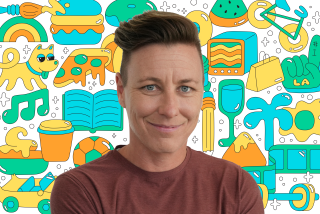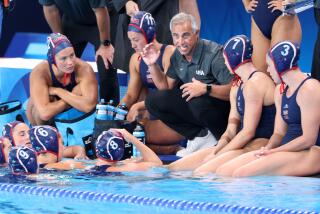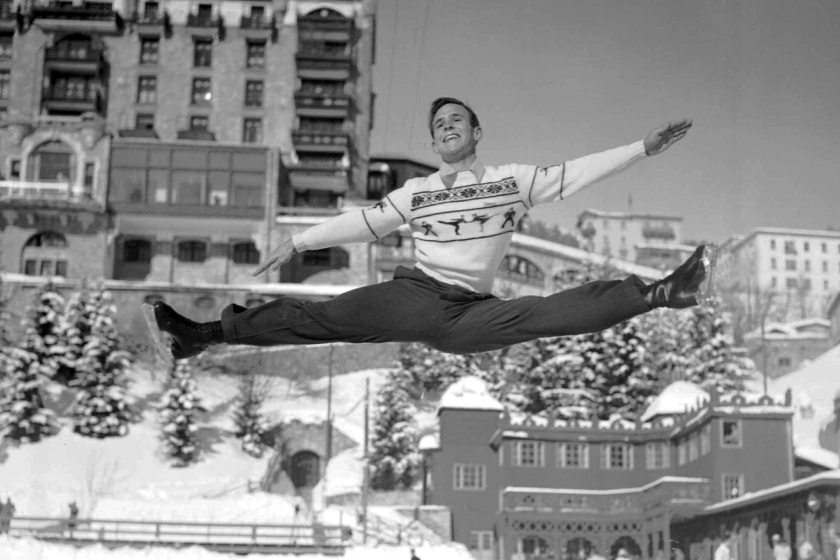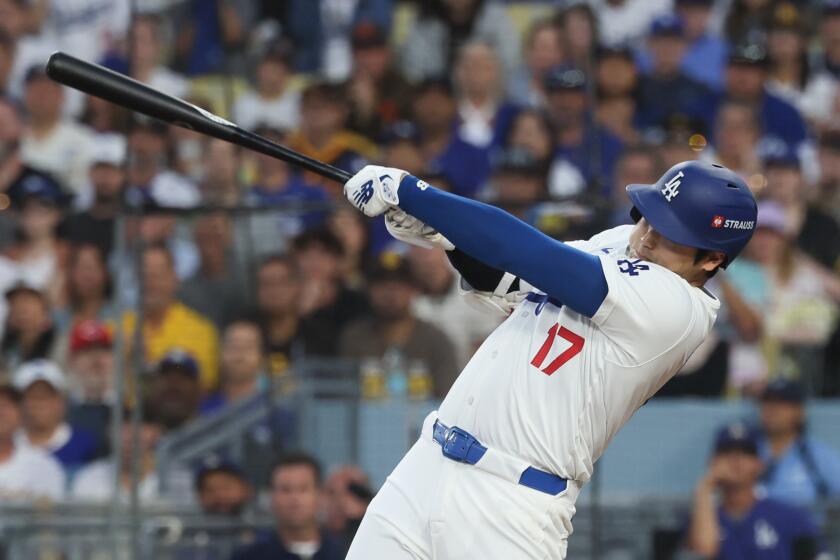Teacher Helps Former Olympians With Life After Sports : Amateur athletes: More than 100 world-class performers have turned to George Weston for career counseling.
- Share via
NEWPORT BEACH — Sitting in the stands during the preliminaries of a swim meet, punching away at his laptop computer, George Weston looks very much like a zealous parent plotting his child’s rise to Olympic glory.
Weston, however, isn’t computing split times, figuring factors of improvement or crunching any numbers. He’s creating a resume for an athlete who’s preparing to face life in a business suit instead of Speedos.
Weston understands the self-discipline, the dedication, the plain hard work it takes to become an Olympian. In fact, it’s all listed under “work experience” on those resumes. He also believes, however, that getting on after the Olympics often can be more difficult than getting in the Olympics.
For some, the idea of life out of the pool, off the snow or ice, out of the gym or out of a kayak can be more frightening than any competition for Olympic medals.
Many amateur athletes, even those who come home with the gold medals around their necks, find themselves ill-prepared to face the future, victims of a disposable society. Sometimes, endorsements provide a brief buffer from reality, but those who haven’t earned college degrees--and many haven’t--soon discover that a triple-twisting dismount or the ability to swim a fast 100-meter breaststroke aren’t exactly marketable skills.
“I look at these kids and I really want to help them back into life,” Weston says. “They have so much leadership potential, so many great qualities.
“I meet them and ask how they’re doing, what’s going on in their lives, if they’re happy. They say, ‘Gee, do you really want to know, George?’ And then sometimes they’ll dump it all out. We deal with everything from education to careers to a death in the family or divorce. If it’s an eating disorder or drugs or alcohol or deep emotional problems, then I refer them. I don’t try to play armchair clinical psychologist.
“I’m just a clearinghouse resource for them. They sometimes are more comfortable talking with me than a coach. Coaches are often very inept when it comes to counseling skills.”
So three years ago, Weston founded the Newport Beach-based American Athletic Academy, of which he is president, job-placement counselor, educational adviser, accountant, resume typist, receptionist, coffee mug washer and, most important, someone to talk to.
There’s nobody else in his office--unless you count the athletic faces framed on the wall behind his desk--but this is no one-man show. Weston’s goal was to expand the scope of his academy beyond his own brand of athlete-counseling and he has developed an ever-expanding network of former athletes, coaches, corporate executives, civic leaders and educational administrators who help athletes get internships, jobs and admission to schools. They also provide one-on-one programs that build the confidence needed to balance the complex demands of school, career development, training and competition.
“George is providing a very valuable and welcome service,” said Terry Schroeder, a three-time Olympian and two-time silver medalist in water polo. “I know a lot of athletes who have come out of sports without any kind of grip on what they were going to do with their life.”
Schroeder is just one of more than 100 former world-class athletes who have responded positively to Weston’s program. And the list is growing every day.
The American Athletic Academy’s national athlete advisory board is a Who’s Who of Olympic gold medalists, including Greg Barton (kayaking), Jeff Campbell (water polo), Tracy Caulkins (swimming), Rowdy Gaines (swimming), Julianne McNamara-Zeile (gymnastics) and Peter Vidmar (gymnastics), to name a few.
All understand the need for the program. Even the athletes who are best prepared for life after sport often battle fears and insecurities.
“I can relate to what it’s like,” said Mike O’Brien, who won a gold medal in the 1,500-meter freestyle in the 1984 Olympics. “I came into the real world and I’d never held a job in my life. I had just trained and that was it.”
And O’Brien, who now owns an insurance and financial services company in Newport Beach, had the advantage of holding a degree in political science from USC.
“Still, I had no confidence,” he said. “I knew I could win in the pool, but I felt really inadequate in a business situation. I mean I had a degree and I still had these feelings. And some of these athletes haven’t even finished high school.”
Most will soon, however, if Weston gets hold of them.
He’s helping three-time Professional Surfing Assn. of America champion Mike Lambresi and bronze-medalist figure skater Peter Oppegard return to college. Both are 31.
Former breaststroke swimmer Steve Lundquist, a double gold edal winner in 1984, has a number of ongoing successful business ventures, but he has relented to Weston’s “badgering” and decided to return to Southern Methodist University and complete the six credits he needs to earn his degree.
And now Lundquist is talking about getting an MBA.
“What I do is not unique,” Weston says. “It’s only unique that I do it. I don’t do anything more for these athletes than empower them to do for themselves.
“Because there are no fees, I only ask that they take on the responsibility to help other athletes. Let’s help them and also make them accountable to society, make them pay back their dues by helping others.”
It makes perfect sense to Weston, who has spent most of his life trying to help others. That’s what teachers do and that’s really what George Weston is: a teacher. He’s taught every level, from preschoolers to graduate students.
After graduating from Harvard, he taught and was headmaster at preparatory schools in New England. He taught at the American school in Vienna. In 1974, he started the American school in Brasilia, Brazil, when the diplomatic community moved into the new city.
He returned to the United States to open a private school, “mostly for boys getting a second or third chance at education,” in the hills above Santa Barbara. And he later opened the first private elementary school in Sun Valley, Ida.
It was in Sun Valley that the foundation for the American Athletic Academy was formed. An avid skier, Weston became friends with Andy Luhn, a former member of the U.S. Olympic ski team who had shattered his leg in a training accident shortly before the 1984 Olympics.
Weston was shocked when he found out Luhn had left school in the eighth grade and never returned. Eventually, Weston met 13 other members and former members of the U.S ski team. Only one had finished college.
“And these were young men and women mostly in their mid-20s,” Weston said. “I asked, ‘Don’t you have tutors in training camp? Don’t you stay on an extension program and then go back to school in the summer?’
“It turns out these kids were totally on their own when it came to getting an education.”
So Weston’s quest began. He got to know Tiger Shaw, captain of the U.S. ski team, and explained his vision to create a program that would ensure education and career placement for the athletes while they trained.
In 1985, he took his idea to the United States Olympic Committee. Their response was: “Good idea. You do it. You fund it.”
In December, 1987, that’s exactly what Weston did. He and four benefactors who believed in his vision put up $1,000 each to get the paperwork started on a nonprofit organization to be called the American Athletic Academy.
In June, 1988, a painting donated by Carlyn Ring sold at a London auction for $163,000, and the academy had its endowment.
That money was about to run out, but Weston’s dream will live on thanks to a recent Coto de Caza fund-raiser. Seven hundred people and about 50 athletes showed up at the $50-a-head party at the estate of Jerry and Joy Dunton.
“We were going out of business on June 1,” Weston said, “but thanks to that fund-raiser, we’re surviving . . . for six more months, anyway.”
Peter Ueberroth once told Weston he was better off running his program outside the suffocating bureaucracy of USOC--and that’s the way it has worked out so far--but Weston can’t help but think the USOC is doing a disservice to itself and this country’s amateur athletes.
“Right now, I have to carry the torch,” he said. “The rewards for me, internally, are very powerful. But it’s all up to me and the responsibility one feels is tremendous.
“The Olympic Committee has missed a great opportunity to keep our athletes involved for life. If we helped the athletes make that final step, oh, there’s plenty of help along the way, but there’s still nothing for transition, then we would be able to say, ‘We helped you, now you help us.’
“And the former athletes would fund the program. And, more importantly, they would give their time, too.”
Many athletes--Schroeder and O’Brien included--are equally optimistic.
Schroeder, a Westlake chiropractor, recently helped former swimmer John Mykkanen, a silver medalist in 1984, get into a prestigious Northern California chiropractic school.
“It wasn’t a big deal, but I got satisfaction from it,” Schroeder said. “If I can help someone reach his goals or adjust to life after sports, it’s a good feeling.
“You know, most of us are used to a team approach. Teamwork has been a big part of our lives for a long time and that’s really all this is.”
O’Brien also believes the bond between athletes would ensure such a program’s success.
“Coming from USC,” he says, “such a big thing is made of the Trojan Family, and there’s a lot to it. Well, I think George has started the beginnings of an Olympic Family.”
If that’s true, it’s a gold medal victory for George Weston.
More to Read
Go beyond the scoreboard
Get the latest on L.A.'s teams in the daily Sports Report newsletter.
You may occasionally receive promotional content from the Los Angeles Times.






